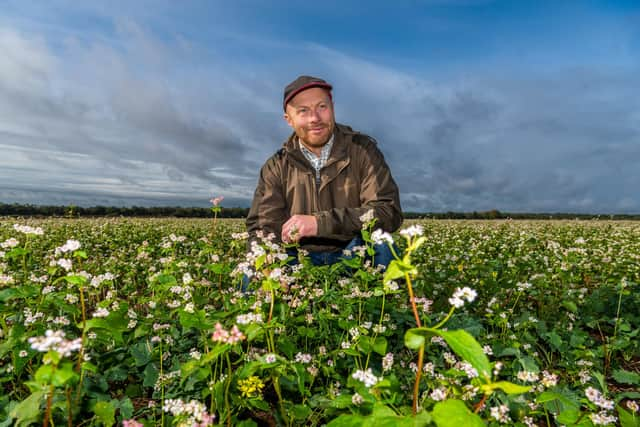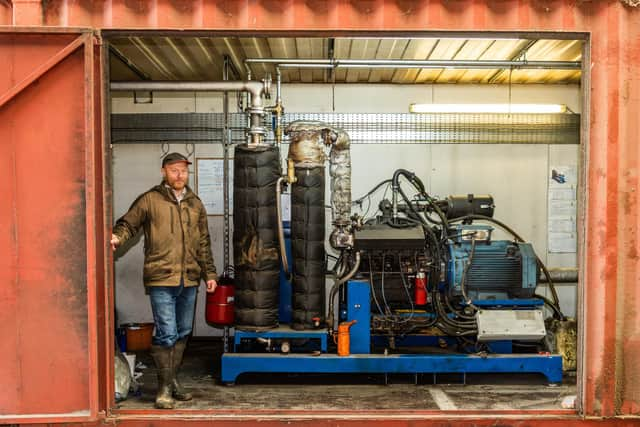Farm of the Week: Former oil worker now passionate about renewables on his Yorkshire arable farm
Mozambique and Angola were just some of Mark Hutchinson’s working destinations and his base was a property in Cape Town. Mark had considered buying a farm abroad but opted instead for where his father, Peter, had moved to in West Ayton near Scarborough, having farmed previously near Castle Douglas in Dumfries and Galloway.
Four years after his return Mark added to the family enterprise by purchasing another farm.
Advertisement
Hide AdAdvertisement
Hide Ad“Dad farmed near Scotch Corner when I was born. We moved to Scotland when I was eight because he was more into cattle and sheep. While I was away he and my mum Janet came back to Yorkshire and we are now a predominantly arable concern.


“We farm 500 acres at Spikers Hill in West Ayton and added the 230 acre farm Magdalen Grange at Gristhorpe, near Filey a few years after I came back. We rent a further 180 acres.
Mark’s career, combined with the incentives that were available at the time, led the farms to solar and wind power generation, which earns through electricity generated going into the National Grid and has saved them money in the form of wood chip powered, gas fired heat and power units on both farms.
“My interest in renewables is possibly more acute than some, having been in the oil exploration world and knowing that it is a finite resource. I know that we should be using it a lot more prudently than we are.
Advertisement
Hide AdAdvertisement
Hide Ad“When the push for renewables came along they were backed financially by the Government and you were guaranteed a good rate of return. You could say it was a risky thing, in the early days, but I was willing to invest in that rather than say a pig shed or something like that where I wouldn’t have been so interested.


Mark says that it’s a pity that there couldn’t be some kind of halfway house on organic farming, something that because there isn’t, he and his father had to make the decision to come out of it.
“Our intention is always to use less nitrogen, less herbicides and insecticides and be more regenerative. When we were organic between 2001-2008 those were our normal practices.
“Dad had always said and we both agreed that organic was great, but that there should really be a halfway ground where if you’ve got a problem, you could spray for it. Organic farming should command a better price for its produce, but it doesn’t always. My feeling is that you should be able to farm somewhere in the middle. That way food will still be better and there would be less run-off into rivers and streams.
Advertisement
Hide AdAdvertisement
Hide Ad“That kind of regenerative approach seems now to be the Government’s sort of thinking with all the SFI Sustainable Farming Incentives coming out.
“We direct drill, we are going no till and we are trying to avoid ploughing.
Mark sees that regenerative principles could change the way he farms in future.
“We are predominantly arable, but with us going more regenerative I can see it sending us back up on cattle numbers again, through the increase in such as herbal leys.
Advertisement
Hide AdAdvertisement
Hide AdThis year’s cropping saw the Hutchinsons harvest 270 acres of winter wheat, of which 100 acres was milling wheat variety Extase and the rest split between Dawsum, Gravity and Graham. It averaged around 4 tonnes per acre.
The rest of their cropping included 125 acres of barley, split between malting and feed barley varieties; 85 acres of oilseed rape; 50 acres of spring beans; 40 acres of oats and 30 acres of rye grown for the first time this year. 100 acres is rented to a couple of potato growers.
“The cereal rye we’ve grown this year will now go into our feed ration for the cattle which will be 50 per cent rye and 25 per cent each of oats and barley,” says Mark. “The rest of the oats go to Morning Foods.
“Our land type at Spikers Hill is half and half limestone and sandstone loam. At Magdalen it is 60 per cent quite good loam and 40 per cent blackish land. We don’t have a major problem with blackgrass. It is brome that is more of a struggle.
Advertisement
Hide AdAdvertisement
Hide Ad“We’ve been on with strip till since 2012-13. We got a direct drill through a grant 3 years ago. The improvements we’ve seen in the soil through strip till have been that we travel much better and we’ve seen a lot more earthworm. It takes a lot less horsepower to do it. When we were predominantly ploughing and combi drilling you’d fluff it all up and then compact it all down. It was tough to work.
Mark says that the two farms being 10 miles apart presents some logistical problems but that they are not overwhelming and that an area that they have tightened up on since his return has been less use of contractors.
“We travel through Eastfield which isn’t so bad. It’s only half an hour on the tractor. We pretty much do everything ourselves. I have two men with me, one full-time the other part-time.
Peter concentrates his efforts more on the livestock operation.
Advertisement
Hide AdAdvertisement
Hide Ad“We finish around 120 Angus-crossed cattle,” says Mark. “We had a pedigree Angus suckler herd until 4 years ago but simplified things and now buy in stores and finish them. We get about 75-80 from a farm in Durham, some from Ruswarp Mart and our stock goes to Dovecote Park on their Angus scheme. We have recently taken on 30 Wagyu as Dovecote Park have also started going down that route.
“We normally buy them about 9 months old in February time and aim to have steers fattened just after Christmas and heifers by the following May. We run them at grass during the summer.
Mark is currently toying with the idea of a small-scale anaerobic digester as part of his regenerative plans that already sees him trading straw for muck with two local farmers and he’s looking at how the new SFI schemes will help in other ways.
“We try to get it back on the land as muck. There’s a lot of energy you could tap into if you had an AD plant but they are so expensive.
Advertisement
Hide AdAdvertisement
Hide Ad“We are in Mid-Tier stewardship and we are looking at the SFI scheme as well. The first version (of SFI) wasn’t exciting, but there are a couple of options now with clover leys and herbal leys where they’ve upped the rates and reduced the requirements on them and I think they could be quite useful. It may impact on the beans and oats crops but if I can’t guarantee myself a tonnage of spring oats at today’s prices we’re maybe better off with SFI’s push for leys.
Mark is chairman of his local NFU branch, a member of an AHDB Benchmarking group and attends Sherburn Agricultural Discussion Group. He’s married to Debra. They have two young boys Eric and Wilfred. The family business also has holiday cottages at both farms.